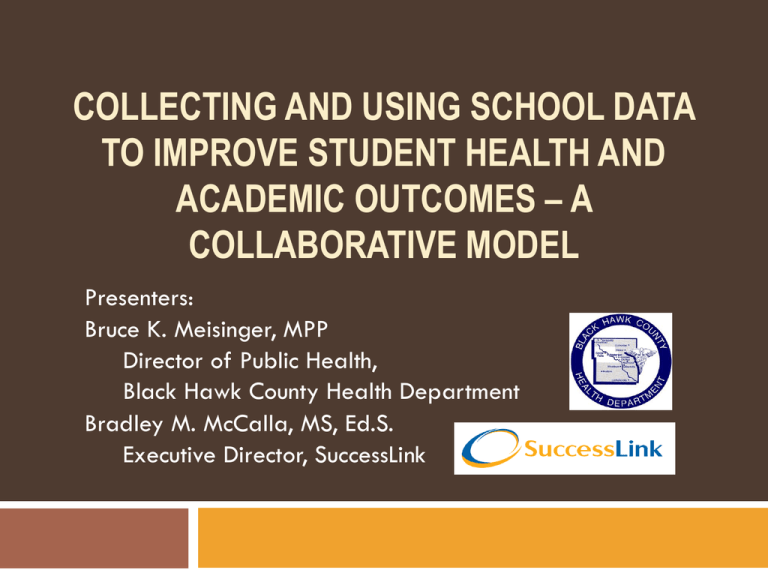Collecting and Using School Data to Improve
advertisement

COLLECTING AND USING SCHOOL DATA TO IMPROVE STUDENT HEALTH AND ACADEMIC OUTCOMES – A COLLABORATIVE MODEL Presenters: Bruce K. Meisinger, MPP Director of Public Health, Black Hawk County Health Department Bradley M. McCalla, MS, Ed.S. Executive Director, SuccessLink Policy Background: Why we share school data? 2 More effectively/accurately track student health: Track and Improve student achievement: Directly measured BMI: Across all grade levels Gender/demographic parameters Large sample size throughout whole school district Increasing scope and complexity of student chronic disease management by school nurses (diabetes, asthma, hypertension,…) High absenteeism/high dropout rate/low graduation rate Gaps in student academic performance Identify areas for effective preventive intervention by school and community intervention strategies. Policy Issue: How we share school data? 3 Black Hawk County Health Department provides: School Nursing Services (contracted) to: Waterloo Community School District (enrollment 10,500) Cedar Falls Community School District (enrollment 5,000) Tri-County Head Start School-based Clinics (Success Street) under a Nurse Practitioner model in 2 Waterloo high schools and 1 middle school with re-positioned collaborating agency services Student Health Services (Clinic) to Hawkeye Community College using similar “Success Street” model Total student population served is large, diverse, dispersed across large metro area/Data difficult to access from multiple IT environments and layers of privacy and confidentiality restrictions The SuccessLink Collaborative Model 4 SuccessLink (formerly Communities In Schools) 501(c)3 Nonprofit community agency Serves as the broker of community services in local school systems (Waterloo, Hawkeye Community College) Success Street School-based Clinics Primary Care – Black Hawk County Health Department Mental Health Services- Black Hawk Grundy Mental Health Substance Abuse Counseling – Pathways Behavioral Health Women’s Health Services – Allen Women’s Health Center Facilitates data sharing between school districts, public health and community agencies. Collaborative Structure of the SuccessLink Model & Data Sharing 5 BHC Health School Nursing/ Primary Care Mental Health Counseling Waterloo Community School District SuccessLink Success Street School Clinics Substance Abuse Counseling Community Groups Serving Student Population Using Data Women’s Health Services 6 How School BMI Data Is Used 7 BMI - % Waterloo K-10 > 85th Percentile(Overweight or Obese) 2012-13 2011-12 2010-11 2009-10 2008-09 2007-08 2006-07 2005-06 2004-05 2003-04 2002-03 2001-02 43% 43% 43% 40% 45% 41% 37% 39% 36% 35% 34% 32% How School BMI Data Is Used 8 BMI - % Waterloo K-10 > 85th Percentile(Overweight or Obese) 43% Male Afri 39% 37% 35% Male Cauc 43% 33% 2012-13 2007-08 53% Female Afri 2001-02 49% 42% 40% 37% Female Cauc 29% 0% 10% 20% 30% 40% 50% 60% 9 How School BMI Data Is Used 10 Public Health (Black Hawk County Health Dept.) Community Health Needs Assessment (CHNA) Indicator Health Improvement Plan (HIP) - planning prioritization factor Grant seeking – needs assessment data Community Funders and Service Agencies Cedar Valley United Way – prioritization of funding allocation among child/adolescent health and wellness project applications Community agencies providing health/wellness service programming for child/adolescent populations (YMCA/YWCA/Boys & Girls Club) Public Awareness Efforts Frequently cited media talking point regarding childhood obesity. Major factor in Waterloo’s selection as a Blue Zone Project site. How Student Outcome Data Is Used 11 Partnering agencies (e.g. YWCA, Boys & Girls Club, Boy Scouts, Food Bank, Head Start) use this data system to measure: Connected by GPA School Data ID, Name, Attendance rates DOB Behavior referrals Specific academic areas (reading, math, science) Extracurricular activities Agency Data Agency program participants are measured over time against themselves, the entire student population or a subset of the student population.











